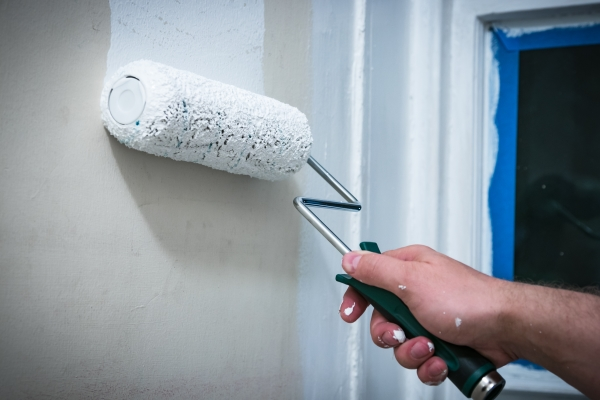
Five Star Painting explains the importance of primer before painting.
|
Taking on a small DIY painting project doesn’t seem like a big deal. However, even a small painting project requires an investment of your time and effort. Before you get started, it’s important to make sure you have everything you need to get the job done right the first time. This includes understanding whether you need to apply a coat or two of primer to the surface you paint. Since the type and condition of the surface you paint will determine whether one, two, or no primer is needed, it’s important to understand how using a primer can make your painting project a success.
Before we go into detail about how, when, and why a primer should be use, we’ll review what a primer is and the purpose it serves. Primer, sometimes called primer paint, isn’t technically paint. Primer’s main purpose is to serve as both a masking and adhesion agent.
If you’re looking to cover a dark paint color with a lighter color, primer helps mask the old color so the new color appears closer to its true hue.
Primer can also help new paint adhere to a surface better, since certain paints don’t bond well to all surfaces. Primer also helps fill in holes and cracks on porous materials (like wood or concrete), and helps paint bond to slick surfaces like aluminum. Here are some examples of how a primer should be used on different surfaces, depending on condition:
- One Coat—New drywall, raw wood, subtle color changes.
- Two Coats—Damaged drywall, stained walls, rusty metal.
- Three Coats or More—Wood paneling, bold color changes.
Related Topic: Factors to Consider When Choosing Exterior Paint Colors
How Much Primer You Need Is Based on What You’re Painting
No two painting jobs will be the same, but there are some general guidelines that you can follow to make sure your project goes as smoothly as possible. Let’s review some of the main situations and materials you’ll encounter and how to deal with each.
As was mentioned briefly above, one of the first things to consider is what you’re painting. Materials like unfinished wood and untreated drywall can absorb paint coats, so you’ll want to make sure you use at least one or two coats of primer to make sure the porous surfaces will be ready for your paint. If you’re going to be working with a material like metal or finished wood, the chance of absorption is less, and you will only need one coat of primer. If the metal is rusty, two coats will prevent the paint from peeling.
Another important factor to consider is what kind of paint is already on the surface you intend to paint. If your surface has no paint, white paint, or is a light color, you might think that you’ll be fine without primer. Although you might be able to get away with it in some cases, it will be better for the overall health of your paint to put down a coat to make the adhesion of the paint a little easier. If you are trying to cover a dark paint, you will probably want to apply two or more coats of primer to really give yourself a fresh workspace. Darker colors will make it hard for a new paint color to be properly displayed.
Although each surface and base color will be different, it’s a safe bet that two coats of primer will achieve any priming goals you have.
Do You Really Need Primer?
Yes, especially for drywall or bold color changes. Although primer may seem like an added expense to your paint project, in the end, it saves you money because primer is much cheaper than paint. New drywall, for example, soaks up paint like a sponge. What might take three or four coats of paint can be accomplished with one coat of primer and maybe two coats of paint.
Don’t even think about painting wood paneling without a few coats of stain-blocking primer. Without a good primer, it could take upward of six coats of paint to cover the wood grain. And even then, the grain still might show through after the paint cures.
What Primer You Should Use
You’ve probably figured out by now that because no painting project is identical, there isn’t a one-size-fits-all primer. Before you put brush to any surface, you’ll want to look at a few different primers to determine which one fits your needs.
Sherwin Williams has multiple options for specific materials, and it would be a good idea to look through their offerings based on your needs. Another thing to consider is the base of the paint you are using. If you plan to use an oil-based paint (like an enamel paint), you’ll want to make sure your primer is also oil-based. The same can be said of water-based paint and primer, however water-based paint can be used over oil-based primers.
Lastly, consider the location of your project. Although it might seem like there shouldn’t be a difference, Behr and Sherwin Williams have options that are suitable for interior and exterior surfaces, but some primers are only rated for interior use. Make sure you purchase the correct product.
Getting Started
If you enjoy painting, a small DIY paint project, or two, is no big deal. Understanding when and how to use primer can help ensure those small paint projects turn out looking good. However, when it comes to bigger paint projects, it’s best to hire a pro. A professional painter has the right tools, knowledge and experience to ensure the job is completed on time and looks great too!
If you have questions, or a painting project you need help with, contact your local painting pros at Five Star Painting. We offer a variety of interior painting services that can help refresh the interior and exterior of your home. To learn more, call us at (888) 261-3633 or book a free estimate online.
This article is intended for general informational purposes only and may not be applicable to every situation. You are responsible for determining the proper course of action for your home and property. Five Star Painting is not responsible for any damages that occur as a result of this blog content or your actions. For the most accurate guidance, contact the Five Star Painting location nearest you for a comprehensive, on-site assessment.
FAQs About Wall Primer
Our years of experience, attention to detail, and decades-long commitment to exceptional customer service set Five Star Painting apart from the competition. Continuing this high standard also includes using our knowledge and experience to answer your most frequently asked questions about using wall primer.
Can I paint without using primer?
While some paints boast “self-priming” capabilities, completely forgoing primer can lead to less-than-ideal results in many situations.
When primer is most important:
- New drywall or unpainted wood: These porous surfaces soak up paint unevenly. A drywall primer provides a seal to help you use less paint.
- Significant color changes: Switching from a dark to a light color often necessitates wall primer to prevent the old color from bleeding through.
- Stained surfaces: Water damage, smoke, or other stains can seep through paint without a stain-blocking primer.
- Glossy surfaces: Primer provides “tooth” for paint to adhere to slick surfaces.
- Repairs: Patched areas need primer to ensure uniform paint absorption.
Situations where you might skip primer:
- If you’re repainting a wall that’s still in good condition, and the new color is very similar to the original color, a high-quality, 2-in-1 paint-and-primer may be a workable option.
If you’re unsure about whether you’ll need primer, contact your local Five Star Painting team for a free estimate.
How do I know if I need one or two coats of primer?
Determining whether you need one or two coats of primer depends heavily on the condition and nature of the surface you're painting.
One coat of primer for drywall and other surfaces may be sufficient for:
- Light color changes: If you're painting over a similar or lighter color, a single coat of primer is often enough to create a uniform base.
- Well-maintained surfaces: If the surface is in good condition, with no stains or significant damage, one coat can provide adequate adhesion for the paint.
- Previously primed surfaces: If the surface has been previously primed and is still in good shape, a single coat may suffice.
Two coats of wall primer are recommended for:
- Dark color changes: When covering a dark or vibrant color with a lighter one, two coats of primer help prevent bleed-through.
- New drywall or unfinished wood: These porous materials absorb primer, so a second coat ensures even coverage and proper sealing.
- Stained surfaces: Water damage, smoke stains, or other blemishes require two coats (or even a specialized stain-blocking primer) to prevent them from showing through the paint.
- Repaired surfaces: Patched areas may absorb primer differently, so a second coat helps create a consistent surface.
- Rusty metal: Two coats can help prevent the rust from bleeding through the final paint job.
These are not the only factors to consider when deciding if you need one or two coats of wall primer. After the first coat dries, carefully inspect the surface. If you see any remaining stains, unevenness, or bleed-through, apply a second coat. The quality of your primer also plays a role. Higher-quality drywall primers often provide better coverage, potentially reducing the need for multiple coats.
What happens if I use the wrong type of primer?
Using the wrong type of primer can lead to a host of frustrating issues, compromising the final paint job's appearance and longevity. For instance, using a water-based wall primer for an oil-based paint can result in poor adhesion, causing the paint to peel or flake.
Similarly, a non-stain-blocking primer won't prevent stains from bleeding through. Standard drywall primers shouldn’t be used on metal, which requires a specialized rust-inhibiting primer to prevent corrosion.
The wrong primer can also create uneven surfaces, leading to visible imperfections in the topcoat. Additionally, it might not seal porous surfaces properly, causing the paint to absorb unevenly and requiring additional coats. Ultimately, mismatched primers and paints can result in a finish that's not only visually unappealing but also prone to premature wear and tear.
Tips for choosing the right wall primer:
- Identify the surface: Metals and other surfaces have different primer requirements than wood and drywall.
- Consider the existing finish: Determine whether the existing finish is oil-based or water-based.
- Address specific issues: If dealing with stains, rust, or glossy surfaces, choose a specialized primer designed for those problems.
- Match primer to paint: Use a similar base for both primer and paint (e.g., water-based primer with water-based paint). Tinted primers can help you match your new topcoat.
- Read the label: Carefully examine the primer's label for its intended use and compatibility.
Primer can be a pain, but it’s an essential part of most painting projects. If you’re unsure which primer to choose or would simply like to save yourself the hassle, call the pros at your local Five Star Painting team! We’ll be happy to handle all of your priming and painting needs.
